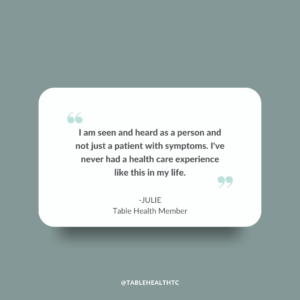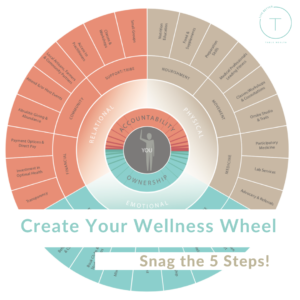As we welcome new Primary Members to the practice, we hear over and over again that they decided to make the switch to Direct Primary Care (DPC) because they want a doctor who has more time to listen and even be available for any urgent needs.
“If people leave and feel that someone was empathetic, compassionate, responsive and listened to them, then we are doing our job, and we are doing something really powerful in this community,” says Table Health Primary Care Provider, Dr. Andrea Stoecker.
The Direct Primary Care (DPC) model delivers for those yearning for a more patient-centered, preventative care approach. It puts patients in control of their health and aims to ensure they feel seen and heard so they can benefit from a more individualized healthcare experience.
To recap, Direct Primary Care (DPC), a growing healthcare model, allows medical practices like Table Health to bypass health insurance and bill the patient directly. This approach to healthcare nurtures a strong patient/provider relationship that supports small changes in lifestyle that can make a huge and lasting impact on our overall health.
Most versions of this model involve a membership structure where patients, families or employers pay a flat monthly fee for access to DPC practice and its physicians.
There are many benefits to this model of healthcare including substantial cost savings. Just one of the ways this DPC saves our patients money is access. At Table Health, we provide on-site and after-hours care, both virtually and in person. With such greater access to primary care physicians, patients don’t always have to visit an urgent care or emergency room. In fact, this care model reduces emergency room visits by as much as 40%*. This greatly reduces the cost of care too.
For those who are growing more concerned about the cost of healthcare for themselves or their families while experiencing significant declines in value and satisfaction, DPC can be a surprisingly affordable option.
With recent average costs of individual health insurance monthly premiums at $440 for an individual and $1,168 for a family, not even including the extra out of pocket costs plus co-pays, a Table Health Primary Membership could save someone a lot of money with $57 as the average monthly membership cost.
Individuals, including those who are unemployed or work part-time, will find direct primary care to be an affordable way to get quality healthcare despite job status. Additionally, some of the ways individuals, families, and even employers save money with a DPC model of healthcare include:
- No CoPays: There are no copays associated with direct primary care, so say goodbye to $35-60 fees
- Less Recurrence: Because there is no concern for copay cost and schedule delays, individuals using a direct primary care model seek out help quicker and more often which reduces the likelihood of health issues getting worse. Quicker medical intervention reduces costs down the road and the agony of a new diagnosis and the symptoms that come with it.
- Upfront Billing: A flat fee through a direct primary care model eliminates surprise bills and most of the paperwork and confusion related to insurance billing. Everything is known up front for your primary care, which is 80% or more of most patients’ medical care.
By removing typical barriers that many face when trying to take care of themselves, including scheduling appointments, finding time, paying a copay and building a connection with a doctor, it becomes easier to focus on preventive medicine. Direct primary care can offer a more integrated health care experience that helps make care a proactive versus reactive experience, which ensures you can take control of your personal health and wellbeing.


